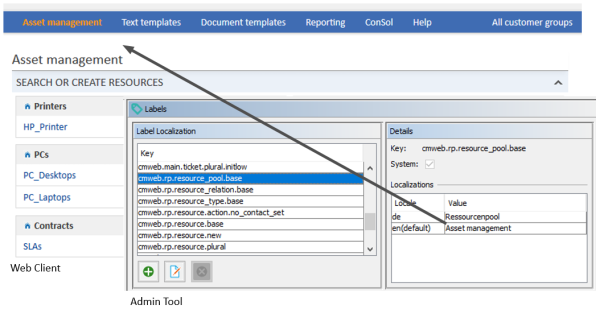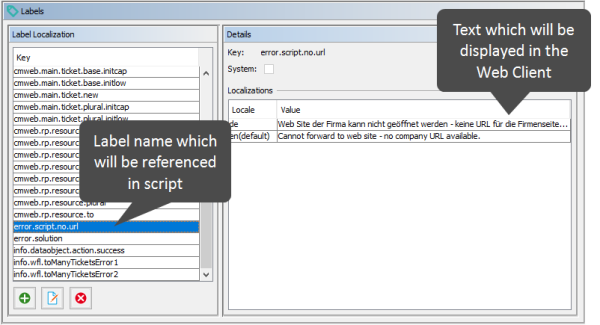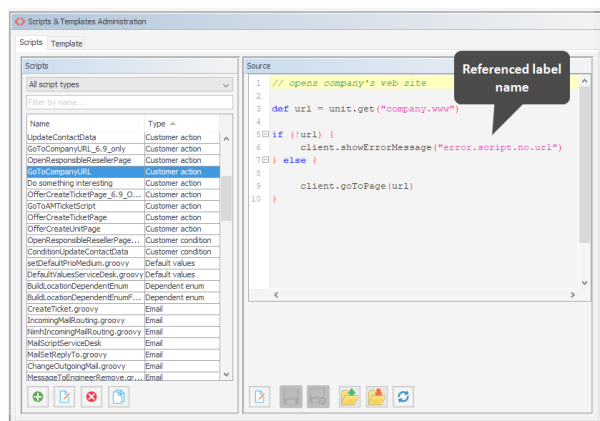Labels
Introduction
It is possible to manipulate labels which are displayed on the GUI, i.e. in the Web Client. In this way, you, as an administrator, can customize the graphical user interface according to your company's requirements concerning terminology and/or Corporate Design. For example, in your company , it might be required to talk about cases instead of tickets, and a queue should be referred to as process. All this can be manipulated using the label settings in the Admin Tool.
Configuring Labels Using the Admin Tool
In the Admin Tool, labels are configured on the navigation item Labels in the navigation group Global Configuration.
Figure 187: ConSol CM Admin Tool - Global Configuration: Labels
The following labels are currently available for tickets, engineers, and resources:
|
Label |
GUI location |
Default value |
|---|---|---|
|
cmweb.main.engineer.base.initcap |
Term for one engineer, capitalized. Used, e.g., in ticket header section. |
Assignee |
|
cmweb.main.engineer.base.initlow |
Term for one engineer. |
assignee |
|
cmweb.main.engineer.plural.initcap |
Term for more than one engineers, capitalized. |
Assignees |
|
cmweb.main.engineer.plural.initlow |
Term for more than one engineers. |
assignees |
|
cmweb.main.queue.base.initcap |
Term for one queue, capitalized. Used, e.g., in ticket list filter. |
Process |
|
cmweb.main.queue.base.initlow |
Term for one queue. |
process |
|
cmweb.main.queue.plural.initcap |
Term for more than one queue, capitalized. |
Processes |
|
cmweb.main.queue.plural.initlow |
Term for more than one queue. |
processes |
|
cmweb.main.ticket.article.dative.initcap |
Demonstrative pronoun (dative) for one ticket, capitalized |
This |
|
cmweb.main.ticket.article.dative.initlow |
Demonstrative pronoun (dative) for one ticket |
this |
|
cmweb.main.ticket.article.demonstrative.initcap |
Demonstrative pronoun (nominative) for one ticket, capitalized |
This |
|
cmweb.main.ticket.article.demonstrative.initlow |
Demonstrative pronoun (nominative) for one ticket |
this |
|
cmweb.main.ticket.article.initcap |
Article for one ticket, capitalized |
The |
|
cmweb.main.ticket.article.initlow |
Article for one ticket |
the |
|
cmweb.main.ticket.base.initcap |
Term for one ticket, capitalized |
Case |
|
cmweb.main.ticket.base.initlow |
Term for one ticket |
case |
|
cmweb.main.ticket.new |
Entry in main menu for "Create new ticket" |
Create case |
|
cmweb.main.ticket.plural.initcap |
Term for more than one ticket, capitalized |
Cases |
|
cmweb.main.ticket.plural.initlow |
Term for more than one ticket |
cases |
|
cmweb.main.ticket.relations.fixed.child |
Term for the ticket on the lower hierarchical level in a relation which can only be set using scripts |
Child (fixed) |
|
cmweb.main.ticket.relations.fixed.parent |
Term for the ticket on the upper hierarchical level in a relation which can only be set using scripts |
Parent (fixed) |
|
cmweb.main.ticket.relations.lax.child |
Term for the ticket on the lower hierarchical level in a relation which can be set in the Web Client |
Child |
|
cmweb.main.ticket.relations.lax.parent |
Term for the ticket on the upper hierarchical level in a relation which can be set in the Web Client |
Parent |
|
cmweb.main.ticket.relations.reference.plural |
Term for tickets in a non-hierarchical relation |
References |
|
cmweb.main.ticket.relations.reference.singular |
Term for a ticket in a non-hierarchical relation |
Reference |
|
cmweb.rp.resource.base |
Title for the resource page and for the resource list on the resource type page |
Resource |
|
cmweb.rp.resource.new |
Entry for "Create a new resource" |
New resource |
|
cmweb.rp.resource.plural |
Term for more than one resources |
Resources |
|
cmweb.rp.resource.to |
Used for the context menu Jump to ... (resource) |
Jump to resource |
|
cmweb.rp.resource_pool.base |
Entry in main menu. |
Resource pool |
|
cmweb.rp.resource_relation.base |
Expression for resource relation. |
Resource relation |
|
cmweb.rp.resource_type.base |
Expression for resource type, e.g. on Detail Search page for resources. |
Resource type |
The terms used for the objects in the customer data model (customer, company, and contact) can be configured as well.
Starting with ConSol CM version 6.11.2.0, the default values for the GUI terms have changed for new installations. The following terms are now used in the Web Client:
|
Definition |
Old wording |
New wording |
|---|---|---|
|
General term for the unit entity in the system |
Customer |
Contact |
|
Unit on the first level of a two-level unit definition or unit of a one-level unit definition |
Contact |
Person |
|
Unit on the second level of a two-level unit definition. Can include several units from the first level. |
Company |
Company |
|
Generic description of a ticket-unit relation |
Customer role |
Contact role |
|
Primary unit related to a ticket |
Main customer |
Main contact |
|
Additional unit related to a ticket |
Additional customer |
Additional contact |
For updates from a previous version of ConSol CM to ConSol CM version 6.11.2.0, the previous values are still used by default.
The following table contains a list of the available labels with the default values for update installations (Value on update) and new installations (Value on setup):
|
Label |
Value on update |
Value on setup |
|---|---|---|
|
cmweb.main.unit.additionalcontact.base.initcap |
Additional customer |
Additional contact |
|
cmweb.main.unit.additionalcontact.plural.initcap |
Additional customers |
Additional contacts |
|
cmweb.main.unit.company.article.initcap |
This |
This |
|
cmweb.main.unit.company.base.initcap |
Company |
Company |
|
cmweb.main.unit.company.base.initlow |
company |
company |
|
cmweb.main.unit.company.jump.to |
Jump to company |
Jump to company |
|
cmweb.main.unit.company.plural.initlow |
companies |
companies |
|
cmweb.main.unit.company.tickets.filter.all.text |
of this company and its contacts |
of this company and its persons |
|
cmweb.main.unit.company.tickets.filter.all.tooltip |
which are relevant for this company. Either the company itself or one of its contacts are main or additional customer |
which are relevant for this company. Either the company itself or one of its persons are main or additional contact |
|
cmweb.main.unit.company.tickets.filter.main.text |
of this company (only as main contact) |
of this company (only as main contact) |
|
cmweb.main.unit.company.tickets.filter.main.tooltip |
where this company is assigned as main customer |
where this company is assigned as main contact |
|
cmweb.main.unit.company.tickets.filter.ofcompany.text |
of this company |
of this company |
|
cmweb.main.unit.company.tickets.filter.ofcompany.tooltip |
where this company is assigned as main or additional customer |
where this company is assigned as main or additional contact |
|
cmweb.main.unit.company.tickets.filter.ofcontacts.text |
of contacts |
of persons |
|
cmweb.main.unit.company.tickets.filter.ofcontacts.tooltip |
which carry one of this company's contacts as main or additional customer |
which carry one of this company's persons as main or additional contact |
|
cmweb.main.unit.company.transfer.select.text |
select another company |
select another company |
|
cmweb.main.unit.contact.base.initcap |
Contact |
Person |
|
cmweb.main.unit.contact.base.initlow |
contact |
person |
|
cmweb.main.unit.contact.jump.to |
Jump to contact |
Jump to person |
|
cmweb.main.unit.contact.plural.initcap |
Contacts |
Persons |
|
cmweb.main.unit.contact.plural.initlow |
contacts |
persons |
|
cmweb.main.unit.contact.tickets.filter.all.text |
of this contact |
of this person |
|
cmweb.main.unit.contact.tickets.filter.all.tooltip |
where this contact is assigned as main or additional customer |
where this person is assigned as main or additional contact |
|
cmweb.main.unit.contact.tickets.filter.main.text |
of this contact (only as main customer) |
of this person (only as main contact) |
|
cmweb.main.unit.contact.tickets.filter.main.tooltip |
where this contact is assigned as main customer |
where this person is assigned as main contact |
|
cmweb.main.unit.contact.tickets.filter.ofcompany.text |
of the company |
of the company |
|
cmweb.main.unit.contact.tickets.filter.ofcompany.tooltip |
|
which are relevant for this person's company. Either the company itself or one of its persons are main or additional contact |
|
cmweb.main.unit.contact.transfer.select.text |
select another contact |
select another person |
|
cmweb.main.unit.general.article.initcap |
This |
This |
|
cmweb.main.unit.general.base.initcap |
Customer |
Contact |
|
cmweb.main.unit.general.base.initlow |
customer |
contact |
|
cmweb.main.unit.general.create |
New customer |
New contact |
|
cmweb.main.unit.general.plural.initcap |
Customers |
Contacts |
|
cmweb.main.unit.general.plural.initlow |
customers |
contacts |
|
cmweb.main.unit.maincontact.base.initcap |
Main customer |
Main contact |
|
cmweb.main.unit.maincontact.base.initlow |
main customer |
main contact |
|
cmweb.main.unit.role.general.initcap |
Customer role |
Contact role |
The terms which are used in the column names of DWH cubes generated using the ConSol CM API are set in the following labels:
|
Label |
Default English |
Default German |
Usage |
|---|---|---|---|
|
cmrf.cube.ticket.main |
Case |
Vorgang |
Columns for basic ticket data and ticket fields |
|
cmrf.cube.queue.main |
Process |
Prozess |
Columns for the technical and localized queue name |
|
cmrf.cube.scope.main |
Scope |
Bereich |
Columns for the technical and localized scope name |
|
cmrf.cube.engineer.main |
Assignee |
Bearbeiter |
Columns for the data of the assigned user |
|
cmrf.cube.maincontact.main |
Contact |
Kontakt |
Columns for the contact ID and contact fields |
|
cmrf.cube.company.main |
Company |
Firma |
Columns for the company ID and company fields |
|
cmrf.cube.customergroup.main |
Customer group |
Kundengruppe |
Columns for the technical and localized customer group name |
For CM Programmers: Defining Labels for Messages
You can also use labels to define error or information messages which should be displayed in the Web Client in certain situations. In this way, you do not have to use only standard CM properties but you can define very specific messages. The following three figures provide an example.
Figure 188: ConSol CM Admin Tool, Global Configuration, Labels - System-specific label used for an error message (1): Label definition
Figure 189: ConSol CM Admin Tool - System, Scripts and Templates: System-specific label used for an error message (2): Script where the label is referenced
Figure 190: ConSol CM Web Client - System-specific label used for an error message (3): Display in the Web Client
You can also work with the MessageProviderService. This class provides a very generic way of using labels, not only for messages, but also for other GUI elements like names in charts or other objects. As you know from other services, a singleton of the class MessageproviderService is potentially available as messageProviderService object in all scripts.
You might need the method getMessage(String pKey). This takes the key of a label as parameter. As a result, the localized value of the label is displayed, according to the default system locale.
Examples, taken from a widget script:
//Some messages used by this widget
title = messageProviderService.getMessage("web.chart.company.ticket.creators.title")
titleNoTicketsYet = messageProviderService.getMessage("web.chart.company.ticket.creators.noResults")
seriesName = messageProviderService.getMessage("web.chart.company.ticket.creators.series")
In case you want to display the message in a specific locale, you can work with the other signature of the method getMessage:
getMessage(String pKey, Locale pLocale). This can also be used for another locale than the standard one.
Example, taken from a workflow script which checks the engineer workload. Here, the standard locale of the engineer who is logged in is used.
// Engineer can only accept ticket if he does not have too many tickets already
def curr_eng = workflowApi.currentEngineer
def max_tics = configurationService.getValue("custom-servicedesk","engineer.max.open.tickets")
// look for open tickets of current engineer
def engs = []
engs.add(curr_eng.id)
TicketCriteria tic_crit = new TicketCriteria()
tic_crit.engineerCriteria = TicketCriteria.EngineerCriteria.assigned(engs as Set)
tic_crit.status = TicketCriteria.Status.OPEN
List<Ticket> open_eng_tics = ticketService.getByCriteria(tic_crit)
def tic_number = open_eng_tics.size
def loc = engineerService.currentLocale
if (tic_number > max_tics) {
log.info 'Too many tickets for engineer ' + engineerService.current + '. Current number is ' + tic_number
// get text from labels defined in AT:
def infoText1 = messageProviderService.getMessage("info.wfl.toManyTicketsError1", loc)
def infoText2 = messageProviderService.getMessage("info.wfl.toManyTicketsError2", loc) + max_tics
// alternative solution: workflowApi.addValidationError("INFO","You have too many tickets (" + tic_number + ") already, so you cannot accept another ticket. Maximum allowed number is " + max_tics)
workflowApi.addValidationError("INFO",infoText1 + " " + infoText2)
} else {
ticket.setEngineer(curr_eng)
}
workflowApi.reinitializeTrigger("defaultScope/Service_Desk/TimeTriggerDesiredDeadline")
Code example 24: Script of activity "New IT ticket (Accept ticket)", engineer workload is checked
A message like this might be displayed in this case:
Figure 191: ConSol CM Web Client - Message for English browser locale if the engineer has too many tickets to accept another one




